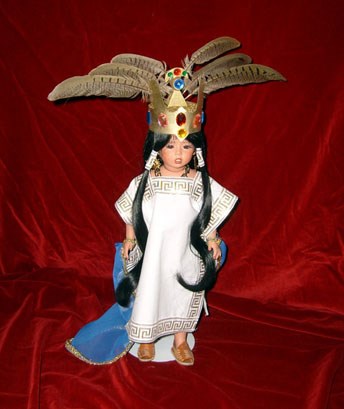
The gilt-edged huipil (tunic) and elegant sheer blue cape, gold sun pendant, and regal bejeweled penacho (headdress) adorned with peacock feathers all relate to the ancient Aztec heritage of Mexico City, the oldest and highest metropolis on the North American continent, and the most populous city in the world. The mammoth pyramids of Teotihuacán indicate the area around Mexico City was occupied by a great civilization, probably Nahuatl in origin. Around 750 A.D., Teotihuacán was abandoned. Between about 900 and 1200 A.D., the Toltec Empire controlled the valley of Mexico. Then in 1325, when the nomadic Aztecs encountered the long-awaited sign of the promised land - an eagle, perched on a prickly pear cactus, holding a snake in its beak - Tenochtitlán, the capital of the Aztec Empire, was founded on a small rocky island in the middle of Lake Texcoco. In just 200 years, Tenochtitlán became a dominant cultural center reaching as far as Central America. Conquered in 1521 by the Spaniards, Tenochtitlán was leveled, and the capital of New Spain was founded on the site that is now the historical center of Mexico City. The Meseta de Anáhuac (Valley of Mexico) where the Federal District is situated also spans Hidalgo, Puebla, Tlaxcala, and the state of Mexico. The valley is surrounded by mountains, and to the southeast loom two snowcapped volcanoes, Popocatépetl and Iztaccíhuatl, both well over 17,000 feet high. In the mid-1990s, Popocatépetl awoke and still occasionally spews smoke, ash and lava. The Federal District is the industrial, financial, cultural and political center of Mexico. Professionals - doctors, engineers, architects, teachers and lawyers - make up a large part of the population; yet, in contrast, the streets still teem with trade: shoe-shiners, mariachis, bird sellers, second-hand clothes dealers, balloon vendors, and sweet potato sellers. Handicrafts include alebrijes (fantastic painted monsters) Judas dolls, piñatas, paper cuttings and basketwork. Mexico City's altitude and climate favor the growth of a wide variety of vegetation, from the cacti on arid northern land, to the orchids, pirul, dwarf oaks, ferns and thickets known as palo loco sprouting from volcanic rock in the south. Some outlying rural areas still cultivate common crops, breed livestock, and live off the land; but ranches, estates and ejidos are gradually being taken over by residential areas, large shopping malls and commercial enterprises. Did you know...? 
El huipil de bordes dorados, la elegante capa azul, el medallón del sol de oro y el real penacho adornado con plumas de pavo real, se relacionan con la antigua herencia azteca de la Ciudad de México, la metrópoli más vieja y más alta sobre el continente norteamericano, también es la ciudad más poblada del mundo. Las pirámides de Teotihuacán indican que el área que circunda la Ciudad de México fue ocupada por una gran civilización, probablemente de origen Náhuatl. Alrededor del año 750 después de Cristo, Teotihuacán fue abandonada. Entre el año 900 y 1200 después de Cristo, el Imperio Tolteca controló el Valle de México. Después en el año 1325, cuando los aztecas nómadas encontraron la anhelada señal de la tierra prometida, un águila encima de un nopal, devorando una serpiente, fundaron Tenochtitlán, la capital del Imperio Azteca, en una pequeña isla rocosa en medio del Lago Texcoco. En tan solo 200 años, Tenochtitlán se convirtió en el centro cultural dominante, llegando incluso hasta regiones tan lejanas como Centro América. Tenochtitlán fue destruida en 1521 por los conquistadores españoles y la capital de la Nueva España fue fundada sobre el sitio que ahora ocupa el centro histórico de la Ciudad de México. Es en la meseta de Anáhuac en el Valle de México, donde está situado el Distrito Federal y que también ocupan los estados de Hidalgo, Puebla, Tlaxcala y el estado de México. El Valle está rodeado por montañas, en el sudeste descansan dos volcanes coronados de nieve, el Popocatépetl y Iztaccíhuatl, ambos miden más de 5,182 metros de altura. A mediados de los años 1990, el Popocatépetl despertó y de vez en cuando lanza humo, ceniza y lava. El Distrito Federal es el centro industrial, financiero, cultural y político de México. Doctores, ingenieros, arquitectos, profesores y abogados, forman gran parte de la población y aúmn así, en contraste, en las calles hormiguea el comercio de los limpiabotas, mariachis, vendedores de pájaros, distribuidores de ropa de segunda mano y vendedores de camote. Las artesanías incluyen alebríjes (monstruos fantásticos pintados), muñecos de Judas, piñatas, papel picado y artículos de mimbre. La altitud y clima de la Ciudad de México favorece en grandes proporciones la vegetación, desde el cactus sobre la tierra árida del norte, a las orquídeas, pirul, robles enanos, helechos y matorrales conocidos como palo loco que crecen en rocas volcánicas en el sur. Algunas áreas rurales todavía cosechan sus propios cultivos, crían ganado y viven de la tierra, pero los ranchos y ejidos han sido invaldidos gradualmente por áreas residenciales, grandes empresas y centros comerciales. Sabías que...? |
Last updated: February 24, 2015
